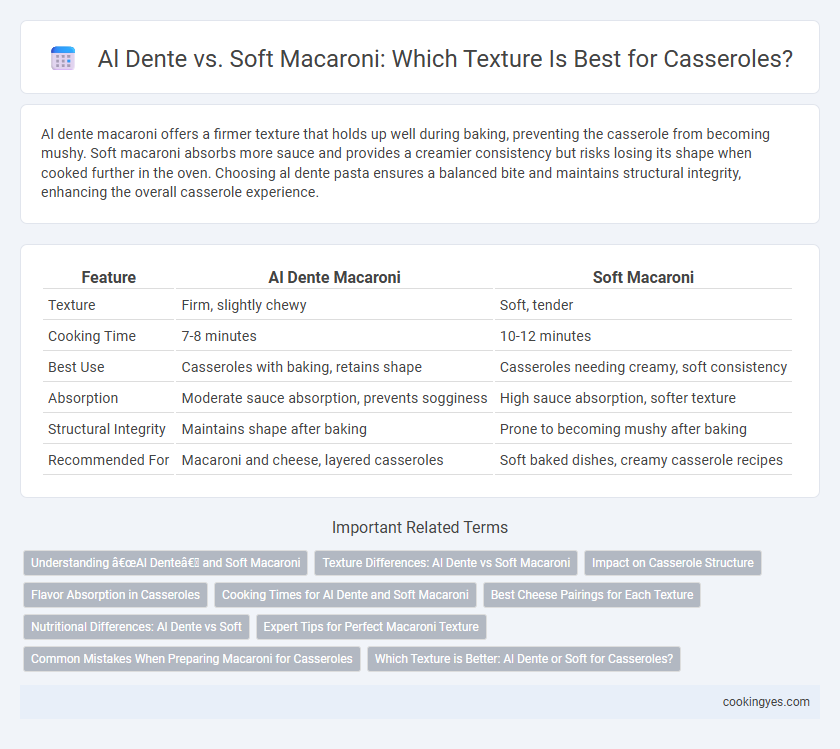Al dente macaroni offers a firmer texture that holds up well during baking, preventing the casserole from becoming mushy. Soft macaroni absorbs more sauce and provides a creamier consistency but risks losing its shape when cooked further in the oven. Choosing al dente pasta ensures a balanced bite and maintains structural integrity, enhancing the overall casserole experience.
Table of Comparison
| Feature | Al Dente Macaroni | Soft Macaroni |
|---|---|---|
| Texture | Firm, slightly chewy | Soft, tender |
| Cooking Time | 7-8 minutes | 10-12 minutes |
| Best Use | Casseroles with baking, retains shape | Casseroles needing creamy, soft consistency |
| Absorption | Moderate sauce absorption, prevents sogginess | High sauce absorption, softer texture |
| Structural Integrity | Maintains shape after baking | Prone to becoming mushy after baking |
| Recommended For | Macaroni and cheese, layered casseroles | Soft baked dishes, creamy casserole recipes |
Understanding “Al Dente” and Soft Macaroni
Al dente macaroni retains a firm texture with a slight resistance to the bite, making it ideal for casseroles where pasta continues to cook and absorb sauce during baking. Soft macaroni, cooked beyond al dente, becomes tender and mushy, which can lead to a creamier casserole but risks becoming overly soggy. Choosing al dente macaroni ensures the pasta maintains structure and absorbs flavors without turning mushy when combined with cheese and other ingredients in casseroles.
Texture Differences: Al Dente vs Soft Macaroni
Al dente macaroni offers a firm, slightly chewy texture that holds its shape well in casseroles, providing a satisfying bite without becoming mushy. Soft macaroni, on the other hand, absorbs more sauce and becomes tender, creating a creamier, more cohesive dish but with less distinct pasta structure. Choosing al dente macaroni enhances individual texture contrast, while soft macaroni prioritizes a smoother, integrated casserole consistency.
Impact on Casserole Structure
Al dente macaroni retains a firmer texture that helps maintain the casserole's structure, preventing it from becoming overly mushy during baking. Soft macaroni absorbs more sauce and moisture, which can lead to a creamier but less defined consistency. Choosing al dente pasta ensures a balance between tenderness and shape integrity, crucial for casseroles that require layering or distinct pasta pieces.
Flavor Absorption in Casseroles
Al dente macaroni retains a firmer texture that allows it to absorb casserole sauces evenly without becoming mushy, preserving both flavor and structure. Soft macaroni tends to soak up excess moisture quickly, which can dilute the sauce's intensity and alter the casserole's intended taste profile. Choosing al dente pasta enhances the balance of flavors by maintaining optimal sauce absorption throughout baking.
Cooking Times for Al Dente and Soft Macaroni
Al dente macaroni typically requires cooking for 7 to 8 minutes, resulting in a firmer texture that holds well during baking in casseroles without becoming mushy. Soft macaroni, cooked for around 10 to 12 minutes, absorbs more moisture and blends smoothly with creamy sauces but risks over-softening when baked. Choosing the right cooking time balances texture and flavor, ensuring the casserole maintains its desired consistency.
Best Cheese Pairings for Each Texture
Al dente macaroni, with its firm and slightly chewy texture, pairs exceptionally well with sharper cheeses like aged Parmesan or sharp Cheddar, which complement the pasta's bite without overpowering. Soft macaroni, ideal for casseroles, absorbs creamy and mellow cheeses such as mozzarella, Gruyere, or a mild cheddar, creating a rich, smooth texture that enhances the dish's comfort. Choosing the right cheese based on macaroni texture ensures optimal flavor balance and an enjoyable mouthfeel in every casserole.
Nutritional Differences: Al Dente vs Soft
Al dente macaroni retains a lower glycemic index compared to soft macaroni, resulting in slower glucose absorption and improved blood sugar control. The firmer texture preserves more resistant starch, which enhances digestive health and promotes satiety. Soft macaroni, cooked longer, tends to have a higher glycemic index and reduced resistant starch levels, potentially leading to quicker energy spikes and less favorable digestion.
Expert Tips for Perfect Macaroni Texture
Expert tips for achieving the perfect macaroni texture in casseroles emphasize cooking macaroni al dente rather than soft, as al dente pasta retains firmness and prevents mushiness during baking. Using high-quality durum wheat macaroni and timing the boil carefully--typically 1-2 minutes less than package instructions--ensures the pasta absorbs sauce flavors while maintaining structure. Expert chefs recommend rinsing al dente macaroni with cold water to stop cooking and tossing with a small amount of oil to prevent sticking before combining with casserole ingredients.
Common Mistakes When Preparing Macaroni for Casseroles
Overcooking macaroni into softness before baking often results in a mushy casserole that lacks texture, as the pasta continues to cook in the oven. Many mistakenly skip the al dente stage, which preserves firmness and prevents the noodles from absorbing excess sauce and becoming gummy. Ensuring macaroni is cooked just until al dente enhances the overall mouthfeel and structural integrity of casseroles like macaroni and cheese or baked pasta dishes.
Which Texture is Better: Al Dente or Soft for Casseroles?
Al dente macaroni retains a firm texture that holds up well during baking, preventing the casserole from becoming mushy and ensuring each bite offers a pleasant chew. Soft macaroni absorbs more sauce and blends smoothly with other ingredients, creating a creamier, more cohesive dish. Choosing al dente macaroni is generally better for casseroles when you want distinct pasta pieces and a balanced texture, while softer macaroni suits casseroles prioritizing moisture and uniform softness.
Al dente macaroni vs Soft macaroni for casseroles Infographic

 cookingyes.com
cookingyes.com